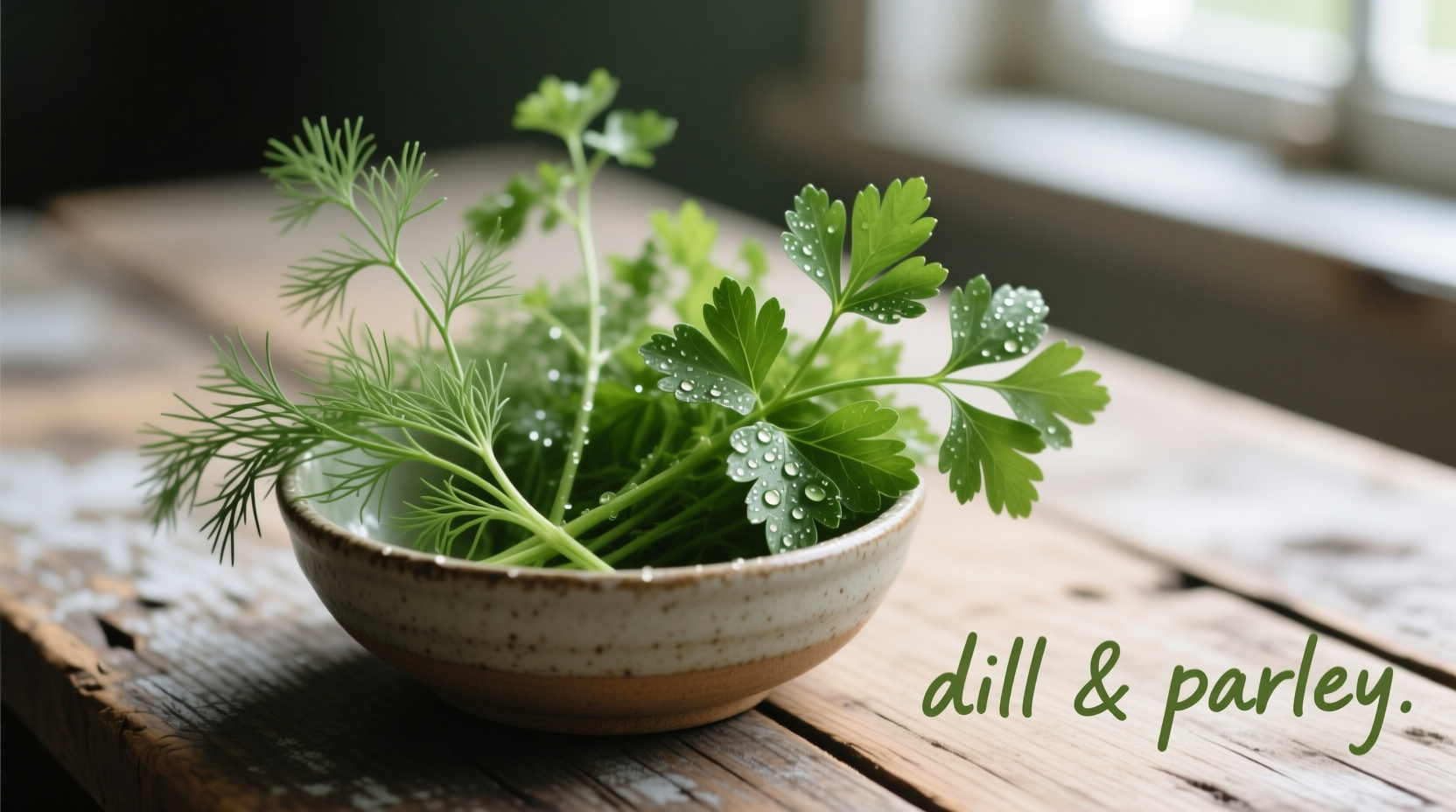When you reach for fresh herbs at the grocery store, dill and parsley often sit side by side, creating confusion about which one belongs in your dish. Understanding the fundamental differences between these two popular herbs transforms your cooking from good to exceptional. Let's explore what makes each herb unique and how to use them properly.
Understanding Flavor Profiles and Botanical Differences
Dill (Anethum graveolens) delivers a distinctive grassy, slightly sweet flavor with subtle anise notes. Its feathery, delicate fronds provide a light texture that works well in delicate dishes. Parsley (Petroselinum crispum), available in both curly and flat-leaf varieties, offers a cleaner, brighter taste with mild peppery notes. Flat-leaf (Italian) parsley has a more robust flavor than its curly counterpart.
| Characteristic | Dill | Parsley |
|---|---|---|
| Flavor Profile | Grassy, sweet, subtle anise notes | Clean, bright, mild peppery notes |
| Best Variety | Feathery fronds (dill weed) | Flat-leaf (Italian) for cooking |
| Heat Tolerance | Loses flavor quickly with heat | Holds up better to cooking |
| Primary Culinary Regions | Scandinavian, Eastern European, Middle Eastern | Mediterranean, global applications |
When to Use Dill: Perfect Pairings and Applications
Dill shines in dishes where its delicate flavor won't get overwhelmed. Scandinavian gravlax relies on dill's anise notes to complement salmon's richness. In Eastern European cuisine, dill transforms cucumber salads and borscht with its fresh character. Middle Eastern yogurt sauces like tzatziki gain complexity from dill's subtle sweetness.
For best results with dill:
- Add at the very end of cooking or as a fresh garnish
- Pair with fish, especially salmon and trout
- Combine with lemon, garlic, and yogurt
- Use in potato salads and egg salads
- Preserve in pickling brines for cucumbers and beets

When to Use Parsley: Versatile Culinary Workhorse
Parsley serves as the foundation for many classic preparations. French bouquet garni relies on parsley stems along with thyme and bay leaf to build flavor in stocks and braises. Italian gremolata combines chopped parsley with lemon zest and garlic to finish osso buco. Middle Eastern tabbouleh features parsley as the star ingredient rather than just a garnish.
Professional chefs use parsley in three distinct ways:
- As a garnish - curly parsley adds visual appeal to finished dishes
- As a flavor component - flat-leaf parsley contributes substantive flavor to sauces and salads
- As the main ingredient - in dishes like Lebanese tabbouleh where parsley comprises 75% of the mixture
Substitution Guidelines: Can You Swap Dill and Parsley?
While dill and parsley look somewhat similar, they're not direct substitutes. Replacing dill with parsley in Scandinavian gravlax would miss the essential anise note that defines the dish. Conversely, using dill instead of parsley in tabbouleh would create an unbalanced flavor profile.
When substitution becomes necessary:
- Dill substitute: fennel fronds (for similar anise notes) or a combination of tarragon and chervil
- Parsley substitute: cilantro (in Latin/Asian dishes) or a mix of chives and basil for Mediterranean recipes
- For garnish only: chervil or celery leaves can mimic parsley's appearance
According to culinary research from the Culinary Institute of America, successful herb substitution depends on matching both flavor profile and texture. Dill's feathery structure wilts faster than parsley's sturdier leaves, affecting both appearance and flavor release in dishes (Culinary Institute of America, 2024).
Storage Techniques for Maximum Freshness
Both herbs require proper storage to maintain their delicate flavors. Treat dill like cut flowers: trim the stems and place in a glass with an inch of water, then cover loosely with a plastic bag in the refrigerator. Change the water every two days. Dill typically lasts 4-5 days with this method.
Parsley proves more durable. For flat-leaf parsley, wrap the entire bunch in a slightly damp paper towel and place in a resealable container in the crisper drawer. Curly parsley maintains freshness longer - up to 10 days with proper storage. The USDA Food Safety and Inspection Service confirms that proper herb storage reduces food waste while preserving nutritional value (USDA FSIS, 2023).
Nutritional Comparison and Health Benefits
Both herbs offer impressive nutritional profiles despite their small serving sizes. A quarter cup of fresh parsley contains more vitamin K than the same amount of spinach, crucial for blood clotting and bone health. Dill provides significant amounts of vitamin A and manganese, supporting immune function and metabolism.
Research published in the Journal of Food Composition and Analysis shows that fresh herbs like dill and parsley contain higher concentrations of antioxidants than their dried counterparts. The study measured flavonoid levels in commonly used culinary herbs and found that both dill and parsley demonstrated strong free radical scavenging activity (Journal of Food Composition and Analysis, 2022).
Common Mistakes Home Cooks Make
Even experienced cooks sometimes misuse these herbs. Adding dill early in the cooking process causes its delicate flavor to evaporate. Using curly parsley in place of flat-leaf in cooking results in a less flavorful dish with unpleasant texture. Chopping both herbs with a dull knife bruises the leaves, releasing bitter compounds.
Professional chefs recommend:
- Using a sharp chef's knife for clean cuts that preserve flavor
- Adding dill during the last 2 minutes of cooking or as garnish
- Removing tough parsley stems before chopping for sauces
- Measuring herbs by volume rather than weight for consistent results
Expert Tips for Maximizing Flavor Impact
Understanding the chemistry behind herb usage elevates your cooking. Dill's volatile oils contain carvone, which provides its characteristic flavor but evaporates quickly with heat. Parsley's myristicin compound contributes to its peppery note and remains stable during cooking.
For restaurant-quality results:
- Create herb oils by steeping parsley in warm olive oil for sauces
- Combine dill with acidic ingredients like lemon juice to preserve its color
- Use dill seeds in pickling for more intense flavor than fresh dill
- Add parsley to dishes just before serving for maximum color impact











 浙公网安备
33010002000092号
浙公网安备
33010002000092号 浙B2-20120091-4
浙B2-20120091-4